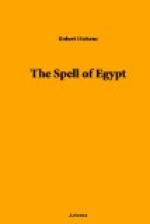I went on, walking with precaution, and presently I saw a man. He was sitting collapsed beneath an archway, and he looked older than the world. He was clad in what seemed like a sort of cataract of multi-colored rags. An enormous white beard flowed down over his shrunken breast. His face was a mass of yellow wrinkles. His eyes were closed. His yellow fingers were twined about a wooden staff. Above his head was drawn a patched hood. Was he alive or dead? I could not tell, and I passed him on tiptoe. And going always with precaution between the tall, grey houses and beneath the lowering arches, I came at last to the Coptic church.
Near it, in the street, were several Copts—large, fat, yellow-skinned, apparently sleeping, in attitudes that made them look like bundles. I woke one up, and asked to see the church. He stared, changed slowly from a bundle to a standing man, went away and presently, returning with a key and a pale, intelligent-looking youth, admitted me into one of the strangest buildings it was ever my lot to enter.
The average Coptic church is far less fascinating than the average mosque, but the church of Abu Sargah is like no other church that I visited in Egypt. Its aspect of hoary age makes it strangely, almost thrillingly impressive. Now and then, in going about the world, one comes across a human being, like the white-bearded man beneath the arch, who might be a thousand years old, two thousand, anything, whose appearance suggests that he or she, perhaps, was of the company which was driven out of Eden, but that the expulsion was not recorded. And now and then one happens upon a building that creates the same impression. Such a building is this church. It is known and recorded that more than a thousand years ago it had a patriarch whose name was Shenuti; but it is supposed to have been built long before that time, and parts of it look as if they had been set up at the very beginning of things. The walls are dingy and whitewashed. The wooden roof is peaked, with many cross-beams. High up on the walls are several small square lattices of wood. The floor is of discolored stone. Everywhere one sees wood wrought into lattices, crumbling carpets that look almost as frail and brittle and fatigued as wrappings of mummies, and worn-out matting that would surely become as the dust if one set his feet hard upon it. The structure of the building is basilican, and it contains some strange carvings of the Last Supper, the Nativity, and St. Demetrius. Around the nave there are monolithic columns of white marble, and one column of the red and shining granite that is found in such quantities at Assuan. There are three altars in three chapels facing toward the East. Coptic monks and nuns are renowned for their austerity of life, and their almost fierce zeal in fasting and in prayer, and in Coptic churches the services are sometimes so long that the worshippers, who are almost perpetually standing, use crutches for their support. In their churches there always seems to me to be a cold and austere atmosphere, far different from the atmosphere of the mosques or of any Roman Catholic church. It sometimes rather repels me, and generally make me feel either dull or sad. But in this immensely old church of Abu Sargah the atmosphere of melancholy aids the imagination.




